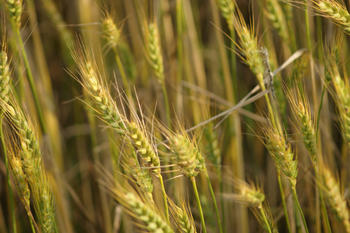Study: Diets in Prehistoric and Early Nonagrarian Societies Were More Diverse than Previously Thought
German-Canadian-Japanese Team of Researchers Published Findings about Okhotsk Culture
Jul 18, 2017
Barley was one of the first domesticated plants in the Neolithic Age.
Image Credit: Frederick Lang Jr. via flickr/ CC BY 2.0
According to a study conducted by paleontologists and archaeologists, the diets of prehistorical and early historical hunter-gatherer societies were more diverse than previously thought. As the archaeobotanical investigation of remains from an archaeological site in northern Japan shows, there was already a special form of hybrid subsistence farming in the Okhotsk culture in the first millennium AD. This was characterized by hunting and gathering on the one hand and the cultivation of completely domesticated plants such as barley on the other hand.
The researchers found that the cultivation of crops did not lead to the community abandoning their way of life as hunters and gatherers. The Okhotsk culture was located in the Northwest Pacific and up to now, known as a typical hunter–gatherer culture specialized in the exploitation of the abundant sea coasts. According to the scientists, these findings are the first scientifically documented example for this special form of hybrid subsistence in the early history of East Asia and are therefore of pioneering importance. The researchers involved in the study are based at the Institute of Geological Sciences, Freie Universität, the German Archaeological Institute, Hokkaido University (Japan), the University of Alberta (Canada), and the Max Planck Institute for the Science of Human History. The findings were published in the latest issue of the PLOS ONE journal.
"We were very surprised to discover proof that domesticated and cultivated plants such as barley were part of the diet of these early societies, but that crop cultivation did not transform the hunting and gathering culture to an agrarian one," stressed the lead author, Dr. Christian Leipe, who coordinated the study. "The newly gained data are a stimulus to question the classification of subsistence strategies in cultures far away in terms of time and space."
During the longest period of its evolution, the human diet was based on hunting and gathering, on the exploitation of natural resources. Only with the beginning of the present warm period, the Holocene, about 11,700 years ago, did people in different parts of the world begin to domesticate plants and animals and become sedentary. This development toward a way of life that is mainly based on agriculture and livestock breeding has long been regarded as a relatively fast, irreversible process that was similar in all parts of the world, even though it did not proceed simultaneously everywhere. Developmental theories followed the so-called dualism principle, which divided prehistoric cultures into two categories: hunters and farmers. In recent years a trend in archaeological research is beginning to show that many communities used different subsistence strategies that cannot be assigned exclusively to one category or the other. Adapted to the resources of their natural environment, these communities used both wild and domesticated species. The authors of the current study based at Freie Universität Berlin, the German Archaeological Institute, Hokkaido University (Japan), the University of Alberta (Canada), and the Max Planck Institute for the Science of Human History in Jena have provided new insights for better understanding such hybrid dietary strategies.
The analysis of fossil macrobotanical remains from the cultural layers of the Hamanaka 2 archaeological site on Rebun Island in northern Japan yielded hundreds of carbonized seeds of naked barley (Hordeum vulgare var. nudum). Through direct radiocarbon dating, the seeds could be attributed to the so-called Okhotsk culture. This community lived on the coasts of the Okhotsk Sea during the 1st millennium AD and between the 5th and 10th centuries also settled parts of the northern islands of Japan. The Okhotsk are known for their highly developed maritime hunting techniques (fish, seal, and whaling), which is why up to now they have been regarded as classical hunters and gatherers. The extensive discoveries of barley from a period of at least 500 years regarded together with traces of significant clearing and opening of the densely wooded landscape, however, indicate that this community of highly specialized hunters also used cultivated crops over a longer period of time. Agriculture was an essential part of the subsistence economy of the Okhotsk communities in Japan.
The study was conducted as part of the international Baikal-Hokkaido Archaeology Project (BHAP, http://bhap.artsrn.ualberta.ca/).
Reference:
http://journals.plos.org/plosone/article?id=10.1371/journal.pone.0174397
Citation:
Leipe, C., Sergusheva, E.A., Müller, S., Spengler III, R.N., Goslar, T., Kato, H., Wagner, M., Weber, A.W., Tarasov, P.E., (2017). Barley (Hordeum vulgare) in the Okhotsk culture (5th–10th century AD) of northern Japan and the role of cultivated plants in hunter-gatherer economies. PLOS ONE 12(3): e0174397.
Further Information
This text was originally published in German by the Office of News and Public Affairs of Freie Universitat on March 30, 2017, as a press release.

